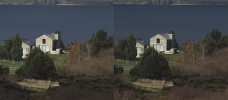Stitching images together isn't doing anything to improve image quality or increase resolution.
If DJI ever makes a bird with a camera that does not have garbage for corners in terms of smearing of details this would be true.
However, I often find that if I am running a photo more than a full page in a magazine, has to go big at a point of sale display, I am wise to do a 4-tile of the same horizontal image in order to add about 20-25% more image area to crop the intended photo out of to get rid of bad image quality in the corners.
As to what others have said here, let’s say you have an image that fills the frame with a 50mm lens. If you use a 150mm lens and shoot multiple overlapping frames and stitch them to achieve the same field of view, you now have more overall resolution.
One of the best examples I have of this was in 2007 as assigned from the Colorado Board of Tourism when they approached me in a panic in needing a super high resolution image of the Maroon Bells to be printed 8’x10’ feet for a trade show in less than a week. They wanted a blue sky day so they could drop in big text in the sky above, budget was $4,000.
These famed peaks are in my neighborhood so I drove up the next morning, carefully shot frames (a lot) with a 200mm lens, stitched them, got them the image and collected payment.
I did a job on Friday where I shot a ranch for sale and used my EVO II for the stills because it actually has good corners (!) but in order to get a vertical, I had to do what I normally do and that is stitch 4-6 horizontal shots. One positive byproduct of that is more resolution in terms of pixel count and it really shows in the image.
And frankly, it has been showing in the printed image for a very long time. For example, if you go through magazine covers of Arizona Highways or Outdoor Photographer from the 90’s, you can really tell even from an 8.5” x 11” printed image which ones were in 35mm, medium format or large format.
People contact print 8”x10” large format negatives for a reason, the image quality gains even at that size are still very much noticeable.











